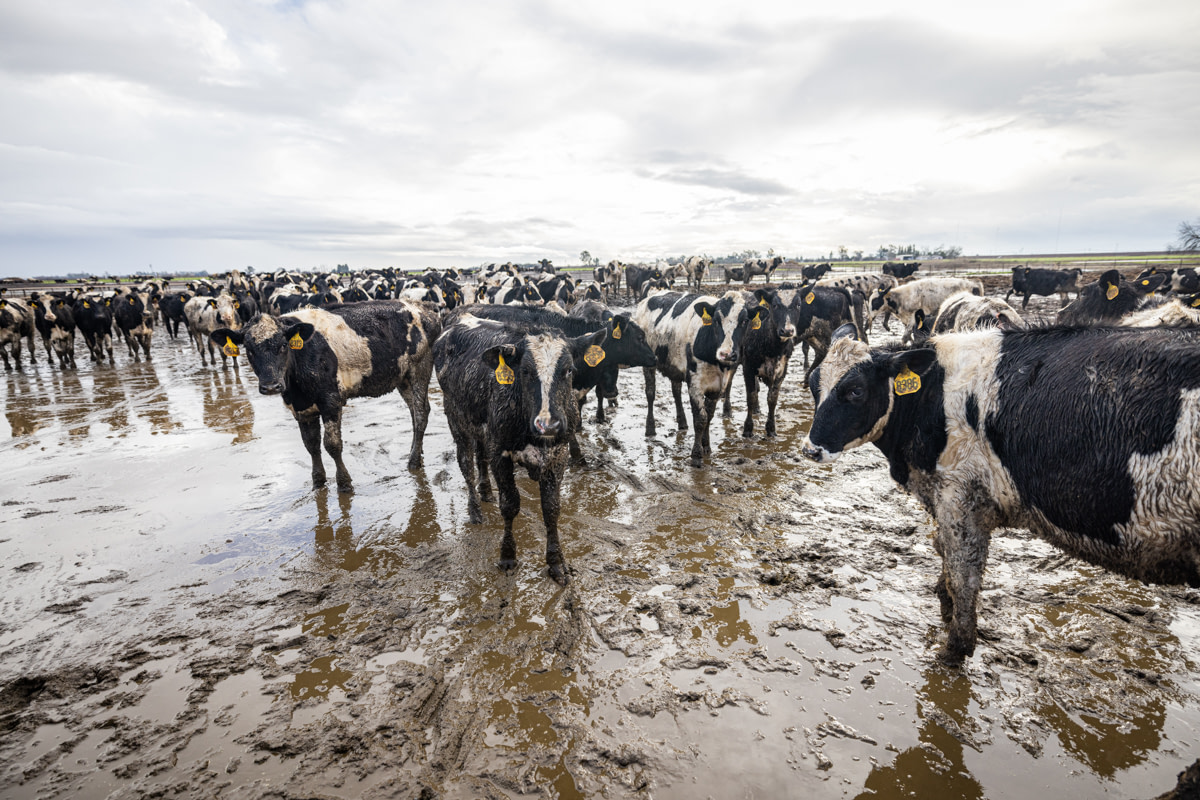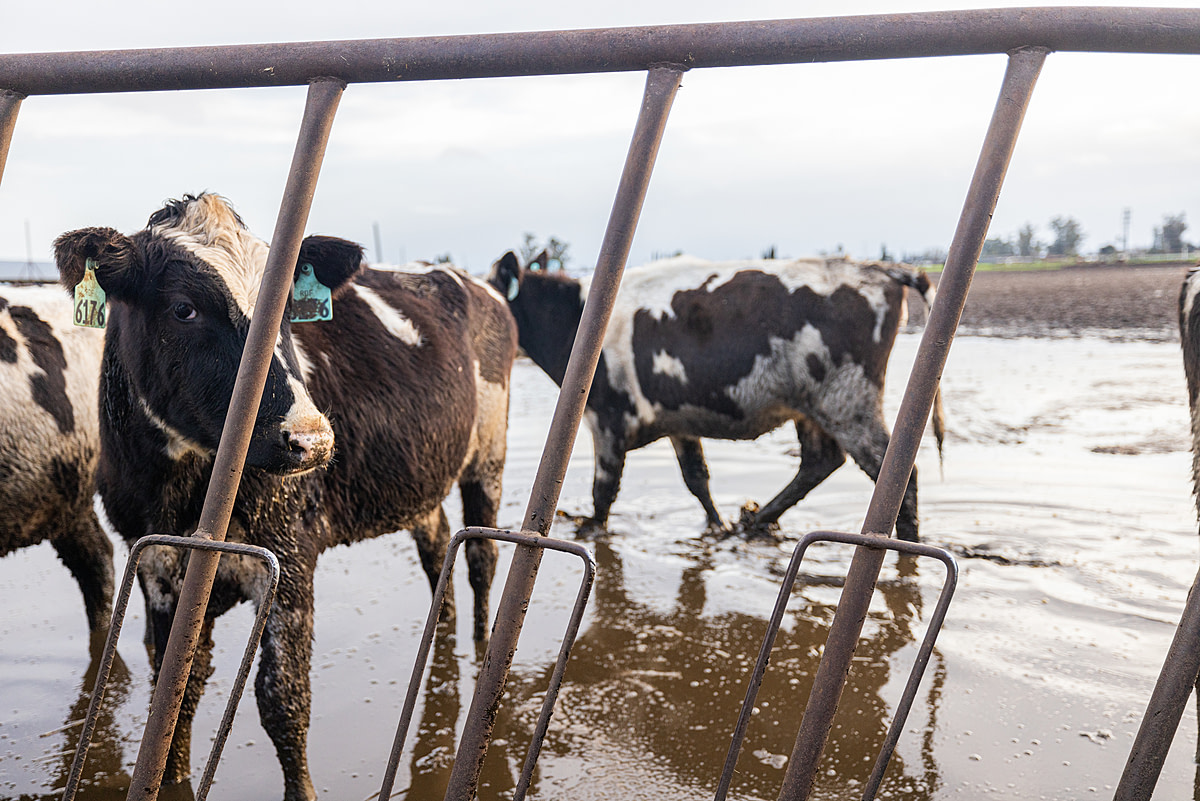Assignment: Farmed Animals in Northern California’s Flood Zones
Aerial view of dairy cows standing in mud and receding flood waters after a series of eight atmospheric rivers battered the state of California since late December 2022. USA, January 13, 2023. Alex Akamine Photography / We Animals Media
Photographer: Nikki Ritcher
Videographer: Alex Akamine
Author: We Animals Media
Explore and download these visuals via our stock platform.
This month, We Animals Media photojournalists Nikki Ritcher and Alex Akamine were on the ground in the Northern California flood zones documenting the impact on farmed animals and the rescue efforts of the local community.
A series of eight atmospheric rivers battered California from late December 2022 to mid January 2023, wreaking havoc across the state. On January 7, wind gusts of up to 50-60 mph (80-96 km/h) toppled trees and caused significant damage, and several levees breached along the Cosumnes River after weeks of non-stop rainfall. As of January 16, nineteen people have died due to these unprecedented storms, and tens of thousands are under evacuation orders as emergency services battle to relocate residents to safe zones.
As always, the total number of animals injured and killed in the aftermath of such extreme weather events is difficult to determine. When numbers are known, they usually relate to the farmers’ economic losses and fail to relate to the experiences of the animals as individuals.
Our photojournalists focused their efforts locally and were able to connect with residents and rescuers to find out more about the rescue and relocation of displaced animals.
In Merced County, flood waters were higher and damage more severe, with record-breaking water levels of more than 26 feet (8 metres). Hundreds of dairy farms and cattle ranches are located in this typically drier and hotter region of California. The sustained back-to-back atmospheric rivers and the levee breaks that occurred on January 7 decimated the community.
One dairy farmer in the area required emergency assistance as water levels rose rapidly, putting the lives of 3,000 calves at risk. Luckily, the farmer was able to get enough rapid response with livestock trailers to save all lives.
Aerial view of dairy cows in enclosures filled with mud and receding water following devastating flooding in Merced County. The flooding was due to a series of atmospheric rivers that battered the state of California starting in late December 2022. Merced, California, USA, January 13, 2023. Alex Akamine Photography / We Animals Media
Emergency response for saving large farmed animals is no mean feat.
“The biggest issue is their size. Whether horses or cattle, you have to have all the right equipment to move them to safety, but then you don’t want to hurt them at the same time… you don’t want them to get [so] upset that they’re going to injure themselves.” ― Robert Kasparian, Battalion Commander
Rescue workers distribute sandbags in preparation for another storm after severe flood levels of up to 26 feet devastated the small community of 4,000 residents. Planada, California, USA, January 14, 2023. Nikki Ritcher / We Animals Media
Often farm animals are not trailer-trained, nor are there evacuation routes set up on flooded properties to get them safely into trailers. This creates a great challenge for rescuers who are evacuating animals from disaster zones. Evacuation also adds unnecessary stress to the animals who are already stressed from the flooded conditions, and puts the lives of those doing the rescue work at great risk as they are forced to operate within the flood zones.
The rescue process can leave animals without food or fresh water for hours at a time, and being in high flooded water levels also brings health risks to the animals. So not only is the rescue critical, but their immediate care following the rescue, including vet help, is too.
Many farmed animals were relocated to different farms in the area, and the Merced County Fairgrounds took in domesticated animals too, including 12 horses who were saved from a flooding ranch.
This isn’t the first time we’ve been on the ground in California to document climate-related animal stories. In 2021, Nikki Ritcher photographed the impacts of wildfires on animals in Caldor, California during the west coast’s hottest summer on record. While on the ground, Nikki witnessed animals displaced and in distress amid smoky and charred landscapes. Fast forward a year and a half and we’re seeing communities devastated by flooding and animals left soaked and covered in mud as the flood waters recede. But one thing remains the same in both scenarios: the scenes of residents and rescuers toiling to save animals in these extreme conditions.
“It’s a community; we’re either going to sink or swim together.” ― Jessica Esau, large animal volunteer
Dairy cows stand in muddy water to reach their feeding troughs following devastating flooding in Merced County due to a series of atmospheric rivers that battered the state of California starting in late December 2022. Atwater, California, USA, January 14, 2023. Nikki Ritcher / We Animals Media
Animal stories are environment stories. These images and video clips are the latest in our collection of visuals documenting the scope and scale of animal agriculture and climate change.
Data sources: ABC News / LA Times / The Guardian / KMPH
Images by Nikki Ritcher. Video clips by Alex Akamine.
Explore and download visuals from this assignment via our stock platform.
Donate today to support us on the frontlines of animal and climate stories.
More like this from We Animals Media:
Assignment: BC Flood Impact On Animal Lives
by We Animals Media | Dec 15, 2021
Documenting the aftermath for animals of Hurricane Florence
by Kelly Guerin and Jo-Anne McArthur | Oct 13, 2018











